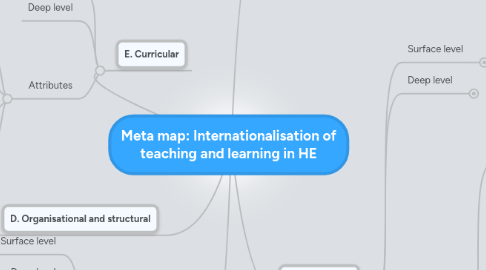
1. C. Ethos and values
1.1. Surface level
1.2. Deep level
1.2.1. feel the need to broaden the horizon
1.3. Attributes
1.3.1. Attitudes on foreign students/mobility (F)
1.3.1.1. Previously international students were expected to adapt independently
1.3.1.2. optimistic
1.3.1.2.1. Students get new knowledge and skills during exchange period abroad
1.3.1.3. pessimistic
1.3.1.3.1. Study breaks and prolonged study times of domestic students (who have participated in student exchange)
1.3.2. values
1.3.2.1. willingness
1.3.2.2. flexibility
1.3.2.3. tolerance /understanding
2. D. Organisational and structural
2.1. Surface level
2.1.1. Course development only through material translation
2.2. Deep level
2.2.1. Course development trough experiences and feedback
2.2.2. Shared pedagogical reflection of teachers
2.3. Attributes
2.3.1. Adaptation and management of change (F)
2.3.1.1. Internationalisation as a process
2.3.1.1.1. Internationalisation slow and phased in practice
2.3.1.1.2. Individual teachers' development effors
2.3.1.1.3. Joint development efforts
2.3.1.2. Organisational resources and support
2.3.1.2.1. Support unclear
2.3.1.2.2. Not necessary training available
2.3.1.2.3. Concern about oversize resource allocation for internationalisation
3. E. Curricular
3.1. Surface level
3.2. Deep level
3.3. Attributes
3.3.1. connection to research
3.3.2. special design of programs, recognition
3.3.3. mentoring
3.3.4. student training for the new environment
4. A. Teaching and learning environment
4.1. Surface level
4.1.1. change of language
4.1.2. adaptation
4.1.3. Diversity of expectations and backgrounds
4.1.3.1. Variety in motivation and interest
4.1.3.2. Variety in students' knowledge and skills
4.2. Deep level
4.2.1. being exposed to cultural difference/learn about differenc cultures
4.2.1.1. content
4.2.1.2. way of learning
4.2.2. important role of communication
4.2.3. challenging own routines
4.2.4. May change the teaching and learning culture
4.2.4.1. Needs for improving pedagogical practices
4.2.4.2. Concern about difficult teaching situations and how to behave naturally in them
4.3. Attributes
4.3.1. Observing changes in student groups (F)
4.3.1.1. Growing number of international students
4.3.1.1.1. Multicultural classes
4.3.1.1.2. Both domestic and international students participate into the courses
4.3.1.1.3. International students as a teaching resource
4.3.1.2. Group processes between domestic and international students
4.3.1.2.1. Students don't like to work in mixed groups
4.3.2. environmental
4.3.2.1. internationalisation @ home
4.3.2.2. better student recruitment
4.3.2.3. mobility
4.3.2.3.1. of students
4.3.2.3.2. of staff
4.3.2.4. Considering/already participating in teacher exchange
4.3.3. transversal
4.3.3.1. intercultural exchange
4.3.3.2. collaboration between teachers
4.3.3.3. international recognition
4.3.4. Enlarging action field (F)
4.3.4.1. International co-operation neworks and contacts
4.3.4.2. Links to connecting international research and teaching
4.3.5. Changes in university teaching and learning environment (F)
4.3.5.1. Visiting scholars bring new sights into teaching
4.3.5.2. Fears that visiting teachers' may change too much the teaching culture
5. B: Teachership
5.1. Surface level
5.1.1. Teaching in english (F)
5.1.1.1. Insecurity of own language skills
5.1.1.2. Development of own language skills
5.1.1.2.1. Participation into language training
5.1.1.2.2. Following others' teaching
5.1.2. new teaching experiences
5.2. Deep level
5.2.1. Own learning and development (F)
5.2.1.1. New dimension to teacher development
5.2.1.2. After struggling may find own ways of practice
5.2.2. Coping the teaching situations with foreign language (F)
5.2.3. Questioning oneself as a teacher (F)
5.2.4. flexibility as a teacher
5.2.5. integration / cooperation
5.2.6. systematic use of feedback
5.3. Attributes
5.3.1. Teachership challenges (F)
5.3.1.1. The change of own teacher identity
5.3.1.1.1. Tolerance
5.3.1.1.2. Versatility
5.3.1.1.3. Enriching experiences
5.3.1.2. Giving up old is never easy
5.3.1.2.1. Token internationalisation
5.3.1.2.2. Fear of new
5.3.1.2.3. Fear of growing work load
5.3.1.2.4. Not excited about changes
5.3.1.3. Pressures of internationalisation
5.3.1.3.1. May cause feelings of inferiority
5.3.1.3.2. Danger of adding competition
5.3.1.3.3. Having to follow more and more international trends
5.3.2. personal
5.3.2.1. communication skills
5.3.2.2. motivation, willigness
5.3.2.3. being exposed to...
5.3.2.4. personal contacts have structural effects
5.3.3. pedagogical / methodology
5.3.3.1. teaching style (e.g. more examples)
5.3.3.2. students style changing (e.g. asking different and more question)
5.3.4. Challenges for...
5.3.4.1. recognising prior learning (e.g. modules)
5.3.4.2. more heterogenity
5.3.4.3. language learning
5.3.4.4. being trained for the new situation
